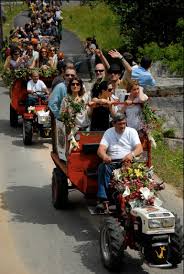Going to the Movies
There is glamour and beauty on the red carpet in Cannes as famous actors, actresses, and directors parade before their films are exhibited to public and jurors. Everyone jostles behind the barriers, trying to catch a glimpse of their favorite star. The people eyes are centered on are a world apart, untouchable. But, in the world of agroglamour, the stars mix freely with film goers and they discuss different points of view of the film world. Because the film festival of Cans is down-to-earth.
And how! Cans is a small parish and village of the same name in the township of Porriño, in the south of Pontevedra, near the Portuguese border. Back in 2004 someone who realized both Cans and Cannes are pronounced similarly in Spanish, decided as a joke, to have a parallel film festival. But, if the festival in Cannes takes place in five-star hotels and historical movie houses, the one in Cans takes place in swept out barns, abandoned houses, wine cellars, and temporarily evacuated chicken coops. And, instead of the international film stars everyone sees in movie houses all over the world, national and local stars grace the lanes and byways of the village, stopping to give talks or chatting with the folks who come out of pure love of films.
 The original joke became a flourishing event. From the initial five hundred visitors, it has grown to expect over thirteen thousand this year. This in a village of around four hundred people. The local people lend their sheds, cellars, barns, and all free available space so that short films and documentaries, mostly regionally made, can be shown in the four days the festival lasts. There is also music and activities for children. Mobility is an issue, because most cars are forbidden from entering during the festival (in a village of four hundred souls, if you introduce ten thousand cars, the people would have to leave to make room for the cars) but on the Saturday of the festival that is solved by the neighbors, who lend their chimpíns, or matraquillos. These vehicles are like miniature tractors but more versatile. If you unhitch the cart from the engine, you can use the engine with different attachable machinery to work the earth. If you see someone in the distance using one of these machines in a field, it looks like they're pushing a mechanical plow without the mule. With the cart hitched, it's used to transport just about everything, people included. You can't get much more agroglamorous than that.
The original joke became a flourishing event. From the initial five hundred visitors, it has grown to expect over thirteen thousand this year. This in a village of around four hundred people. The local people lend their sheds, cellars, barns, and all free available space so that short films and documentaries, mostly regionally made, can be shown in the four days the festival lasts. There is also music and activities for children. Mobility is an issue, because most cars are forbidden from entering during the festival (in a village of four hundred souls, if you introduce ten thousand cars, the people would have to leave to make room for the cars) but on the Saturday of the festival that is solved by the neighbors, who lend their chimpíns, or matraquillos. These vehicles are like miniature tractors but more versatile. If you unhitch the cart from the engine, you can use the engine with different attachable machinery to work the earth. If you see someone in the distance using one of these machines in a field, it looks like they're pushing a mechanical plow without the mule. With the cart hitched, it's used to transport just about everything, people included. You can't get much more agroglamorous than that.
And, like in Cannes, there are prizes in Cans. The mascot of the festival is a yellow dog, because cans is the plural of dog in Galician. It's become the symbol. And the prizes have the mascot on them. There's best film, pick of the public, pick of the jurors, best actor, best actress, etc. Prizes are awarded in the square in front of the church, the largest space in the village. For people who like innovative short films, web series, video clips, or animated shorts, Cans in Galicia is to be preferred over Cannes in France. It's cheaper, too.
And how! Cans is a small parish and village of the same name in the township of Porriño, in the south of Pontevedra, near the Portuguese border. Back in 2004 someone who realized both Cans and Cannes are pronounced similarly in Spanish, decided as a joke, to have a parallel film festival. But, if the festival in Cannes takes place in five-star hotels and historical movie houses, the one in Cans takes place in swept out barns, abandoned houses, wine cellars, and temporarily evacuated chicken coops. And, instead of the international film stars everyone sees in movie houses all over the world, national and local stars grace the lanes and byways of the village, stopping to give talks or chatting with the folks who come out of pure love of films.
And, like in Cannes, there are prizes in Cans. The mascot of the festival is a yellow dog, because cans is the plural of dog in Galician. It's become the symbol. And the prizes have the mascot on them. There's best film, pick of the public, pick of the jurors, best actor, best actress, etc. Prizes are awarded in the square in front of the church, the largest space in the village. For people who like innovative short films, web series, video clips, or animated shorts, Cans in Galicia is to be preferred over Cannes in France. It's cheaper, too.


Comments
Post a Comment